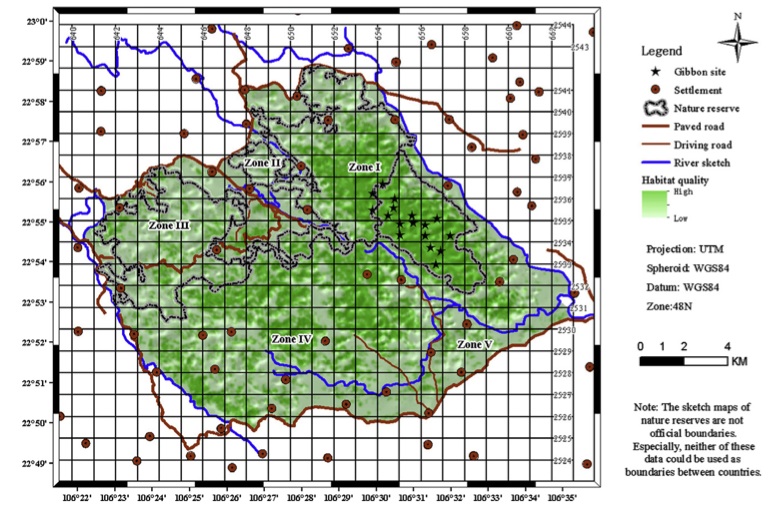Saving the Cao Vit Gibbon, the Second Rarest Ape in the World
Setting aside additional protected areas and creating forest corridors could help this Asian primate bounce back from just 110 individuals
A baby cao vit gibbon learns to search for food. Photo: Zhao Chao 赵超, Fauna and Flora International
You probably haven’t heard of the world’s second rarest ape, the cao vit gibbon. Scientists know of only one place the species still lives in the wild. In the 1960s, things got so bad for the cao vit gibbon that the species was declared extinct. But in 2002, to the surprise and elation of conservationists, the animals—whose shaggy coats can be a fiery orange or jet black—turned up along Vietnam’s remote northern border. Several years later, a few gibbons were found in China, too.
Also known as the eastern black-crested gibbon, the cao vit gibbons once covered an expanse of forest spanning from southern China and northern Vietnam just east of the Red River, but today only about 110 individuals survive. This gibbon is highly inclined to stick to the trees—in a previous study, during more than 2,000 hours spent observing gibbons in the field, researchers saw only once and very briefly one young male cao vit gibbon come down from the canopy and walk on a rock for a few seconds. Population surveys based on watching the animals in the branches reveal that the gibbons live in 18 groups scattered throughout the area. That makes it the second least populous species of ape, just after the Hainan gibbon, another type of extremely rare gibbon living in the same area of Asia.
In 2007 and 2009, Vietnam and then China hustled to establish special protected areas dedicated to preventing the cao vit gibbon’s extinction. Much of the area surrounding the remaining populations of gibbons is quickly being converted to agricultural fields and pasturesor cut down to make charcoal to sell and use at home, a common practice in the area. Hunting—though illegal—is also an issue, as exotic wild meat dinners are popular with locals in the region.
For an endangered species to recover rather than just survive, it needs to grow in numbers. But any given patch of land can only support so many animals given the amount of food and space that’s available. If populations exceed this threshold—called a carrying capacity—then animals will either starve, get picked off by predators or have to move somewhere else.
Researchers from Dali University in Yunnan, the Chinese Academy of Sciences in Kunming and the Chinese Research Academy of Environmental Sciences in Beijing wanted to find out how much of the protected forest the cao vit gibbons had expanded into, and also how many animals that pocket of land could eventually support. To answer this question, they turned to high-resolution satellite images, describing their results in the journal Biological Conservation.
Once they acquired aerial images of the gibbons’ habitat, they classified it into forest, scrub, shrub land and developed areas. This was important because gibbons can only live high in forest canopies, meaning the latter three categories were out of bounds for potentially supporting the animals. Overall, the area could be divided into five different zones that were split apart by either roads or rivers. From there, the researchers plugged the data into computer models that ranked possible gibbon habitat from high to low quality.

Habitat quality over the five zones the researchers identified. Stars mark sites where gibbons currently live. Image from Fan et al., Biological Conservation
Their results revealed several bits of news, some good and some bad. First, from the models it seems that 20 groups of gibbons could eventually live in the protected forest areas before the population reaches its carrying capacity threshold. However, as human development creeps closer and closer, that disturbance could lower that figure. As things stand, the gibbons will likely reach their carrying capacity in the current habitat in 15 years, which doesn’t bode well for building up the species’ numbers.
There are a couple options. The protected area isn’t all great habitat, it turns out. Some of it is just mediocre for gibbons. If that span of forest could be improved, it could eventually support up to 26 groups of animals. The researchers also identified two other potential areas where gibbons could live if they could somehow manage to travel there (no gibbon has ever been known to cross a river or a road). But these patches of welcoming forest, located in Vietnam, are not protected, so they likely will not remain forests for long. If the government decided to protect those areas, the researchers write, they could serve as places for cao vit gibbons to live in the future, especially if narrow corridors of trees connecting the two areas were protected and restored as well.
If these patches of forest were protected, gibbons would not be the only species to benefit. Numerous other species of primates and monkeys, civets, pangolins, porcupines, birds, bats and many more depend upon those last remaining jungle habitats for survival. “In summary, the last remaining population of cao vit gibbon is nearing its carrying capacity in the current remaining forest patch,” the authors write. “Forest protection and active forest restoration using important food tree plantings to increase habitat quality and connectivity should be the most critical part of the ongoing conservation management strategy.”
/https://tf-cmsv2-smithsonianmag-media.s3.amazonaws.com/accounts/headshot/Rachel-Nuwer-240.jpg)

/https://tf-cmsv2-smithsonianmag-media.s3.amazonaws.com/accounts/headshot/Rachel-Nuwer-240.jpg)